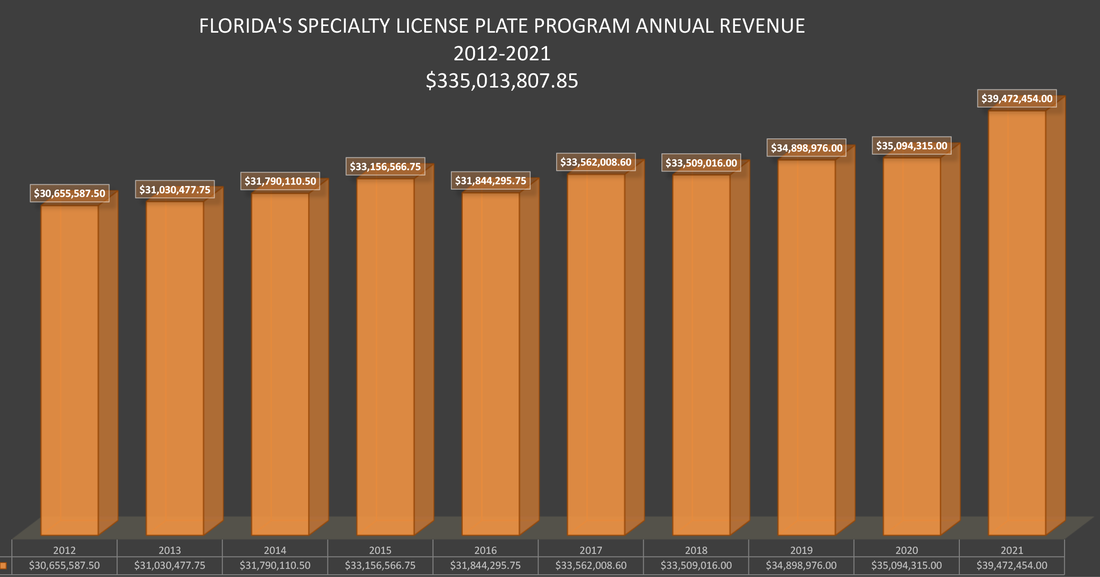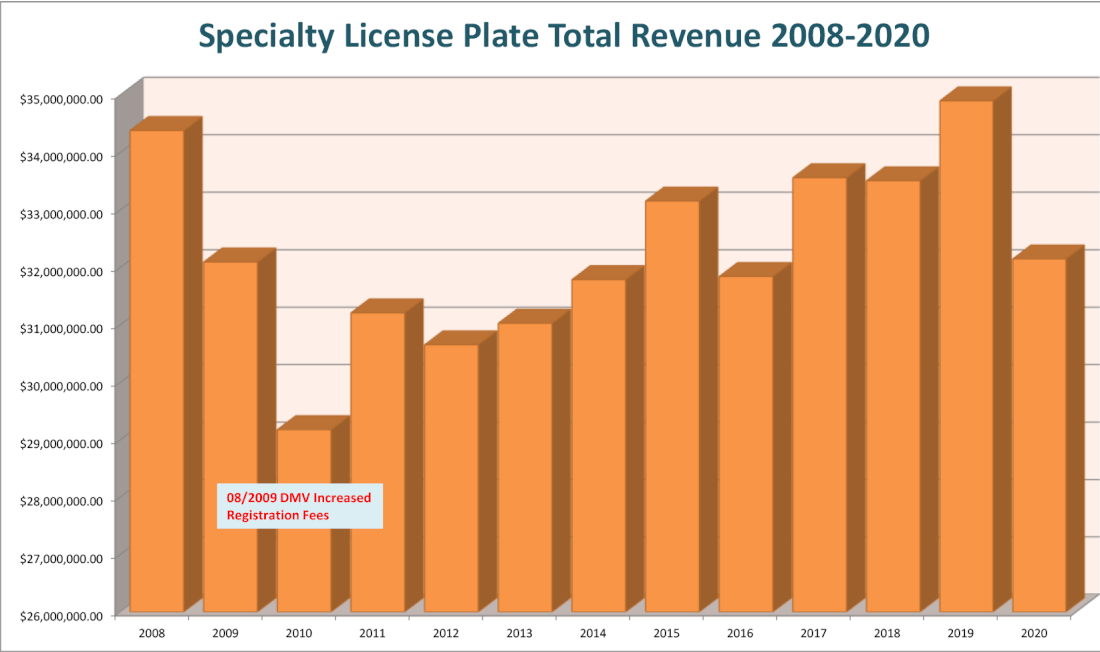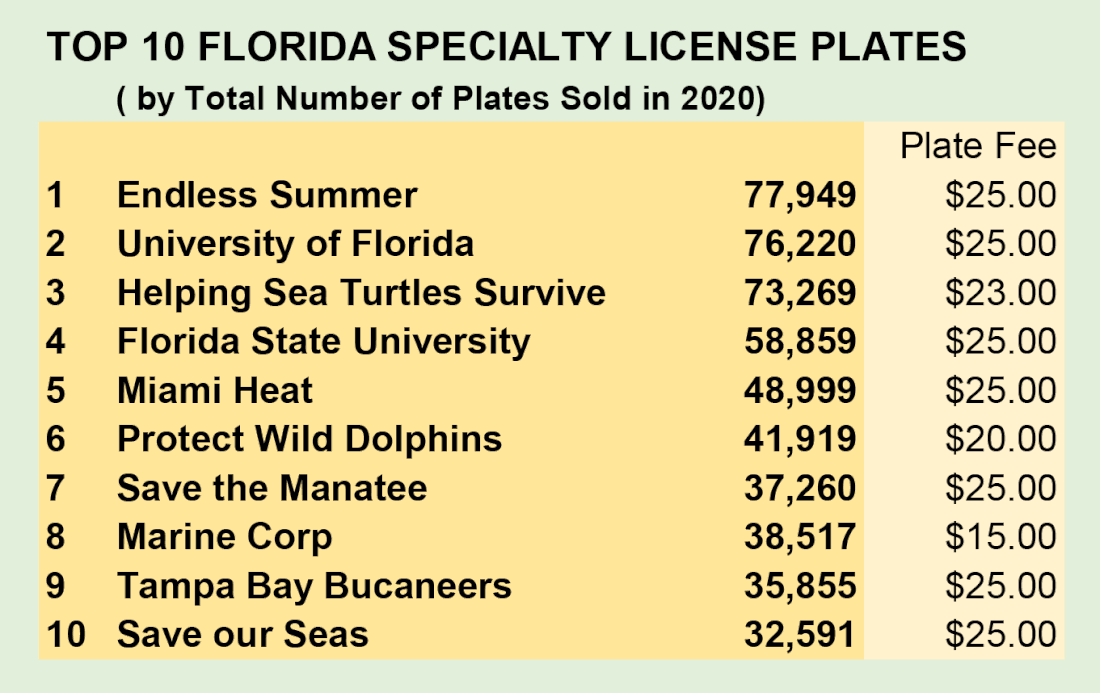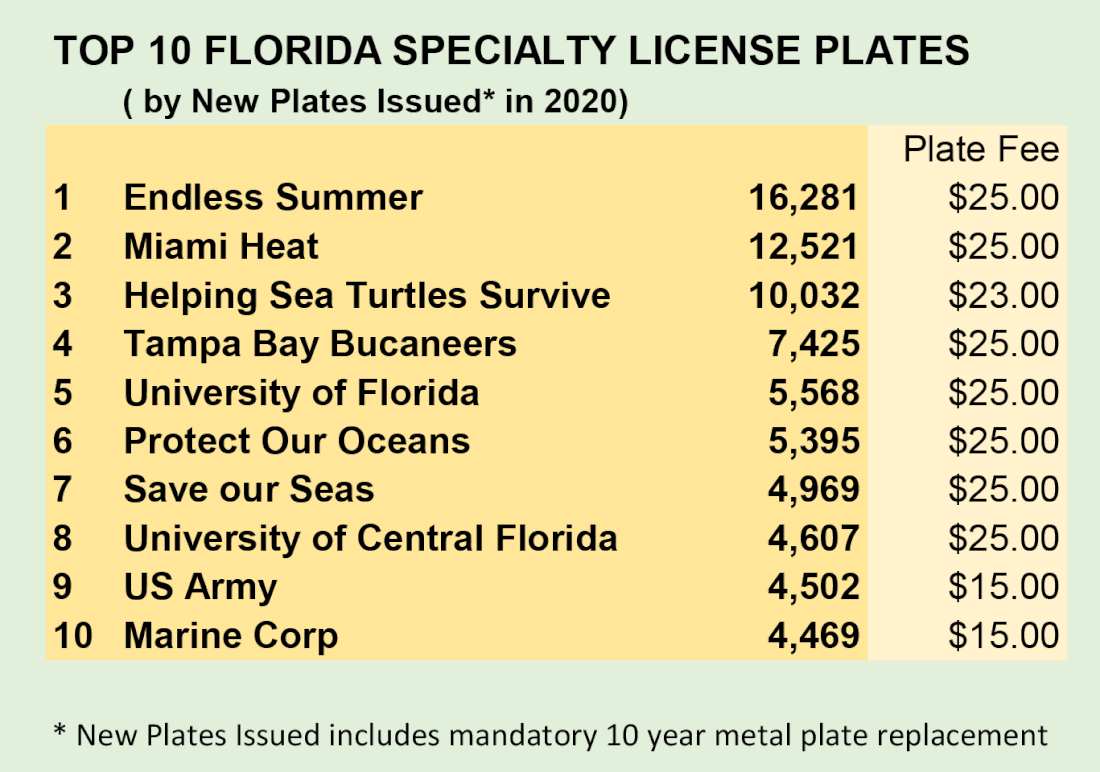|
According to the latest statistics released by the Florida Department of Highway Safety and Motor Vehicles, 1,816,588 specialty license plates were sold in 2021 and a total of $39,472,454.00 was raised, the highest amount in the history of the program.
Prior to 2009, specialty license plate sales increased every year, despite the economic recession. On October 1, 2009, the Florida State Legislature significantly increased vehicle registration fees, particularly with respect to purchasing specialty license plates. In 2009, annual sales of Florida Specialty License Plates amounted to 1,623,486. After 2009, there was a 19.78% decline in Specialty Plate sales, reflecting approximately $7 million lost in annual revenue. In September, 2013, the Florida Legislature reduced some fees associated with vehicle registrations, however, did not address the significant increase in the cost to purchase a new specialty license plate that was imposed in 2009. Despite the increase in fees, specialty plates have now surpassed thospre-2009 numbers, although the number of Florida residents - and Florida registered vehicles - has also significantly increased.
0 Comments
Prior to 2009, specialty license plate sales increased every year, despite the economic recession. On October 1, 2009, the Florida State Legislature significantly increased vehicle registration fees, particularly with respect to purchasing specialty license plates. In 2009, annual sales of Florida Specialty License Plates amounted to 1,623,486. As a direct result of those increases fees, there was a subsequent 19.78% decline in Specialty Plate sales, reflecting approximately $7 million lost in annual revenue. In September, 2013, the Florida Legislature reduced some fees associated with vehicle registrations, however, did not address the significant increase in the cost to purchase a new specialty license plate that was imposed in 2009. Despite the increase in fees, specialty plates have had begun to get back to the 2008 numbers. However, according to the latest statistics released by the Florida Department of Highway Safety and Motor Vehicles, 1,382,959 specialty license plates were sold in CY 2020, this is 8.1% (121,997) lower than the total specialty license plates that were sold in CY 2019 (1,504,956). Revenue fell to $32,149,618.00 for CY2020 from $34,898,976.00 in CY 2019. A loss of $2,749,358.00 (7.9%). Biennial fees (2 year registrations) were also down in 2020, falling to $6,198,728.00, compared to $6,494,715.00. A loss of $295,987.00 (4.6%). The 1,382,959 specialty plates represent 8.2% of the 16,844,969 Florida registered vehicles. In CY2020, 183,906 new plates were issued and 1,199,053 were renewed. In CY2019, 212,911 new plates were issued and 1,292,045 were renewed.  Endless Summer, designed by Michael Towner and Steve Diossy, has now surpassed the University of Florida as the top selling specialty license plate in Florida, notwithstanding generating slightly less revenue this year compared to 2019. Miami Heat and Tampa Bay Bucs both increased their sales and revenue in 2020, the only two specialty plates to do so in the Top 10. 10,193 Presale Vouchers were sold in 2020, representing $336,369.00 total revenue, with $254,825.00 of those fees to be distributed to the presale voucher organizations, provided they complete their presales goal within two years of October 16th, 2020. So far in the 2021 Florida State Legislative Session, 5 new specialty plates have been proposed and bills have been filed for the following: Explore our State Parks - Rep Allison Tant (D-Leon County) / Senator Dennis Baxley R-Lady Lake Inter Miami CF - Senator Manny Diaz (R-Hialeah Gardens) Toastmasters - Senator Linda Stewart (D-Orlando) Gopher Tortoise - Senator Linda Stewart (D-Orlando) Orlando United - Senator Linda Stewart (D-Orlando) About 200 marketing and creative types gathered last August in Oklahoma City to start the process of giving Oklahoma a new look. It was a hard sell at first. People sat with arms crossed holding back some cynicism and started venting about the ills facing the state, from underfunded schools to high incarceration to frustrating politicians. Then Tulsa’s Blake Ewing raised his hand. “People wanted the chance to complain about the parts of Oklahoma not worth bragging about,” Ewing recalled. “I brought up that Nashville had bad public transportation. It’s not good, and they constantly fight over it. But the Nashville brand is Music City. They didn’t brand themselves Music City with Terrible Public Transportation. They have a good brand. “That’s what marketing is. It makes a compelling case for the unique attributes you have that are worth seeing. We’ve got so much good here worth sharing.” Ewing — the creative director of OKPOP and a member of the Tulsa World Community Advisory Board — changed the tone of the room. “That was a productive day,” Ewing said. “After that beginning — and even I was one of those sitting with my arms crossed — we said, ‘OK, let’s now start talking about what is great about us.’ We started engaging about those things with themes rising to the top. We worked hard to distill our thoughts about what gets at our personality traits of Oklahoma and things that make us proud to be Oklahomans.” Lt. Gov. Matt Pinnell led the effort to update the Oklahoma image. He argues that selling a state’s bright spots can go hand in hand with improving the troubling areas. “I’m a big believer in marketing in that if you do not invite people to a state, they will not come,” Pinnell said. “If you don’t court people to a state, they will not come. To court people, you have to make an investment. There are things we are fixing at the state Capitol at the same time. “At the end of the day, it comes down to sales. We can sell our positives while tackling the barriers we have in the state. It’s frustrating when a city or state runs short of money, the first thing they cut is marketing. That’s counter-productive. That’s the one thing reaching out in a positive way.” Last week, Oklahoma officials unveiled the state’s new image: a white star surrounded by multi-colored chevrons and the tagline “Imagine that.” Opinions heated up quickly. Imagine that. And there’s the punchline. The tagline is usually used as a sarcastic response, so it’s a risky move. Pinnell sees it differently. “It is all in how you use it,” he said. “I would describe it as a little bit of a swagger in the way we would be using it.” Think of being in a busy Dallas airport and seeing a photo of wide, open roads and the saying, “Oklahoma has 20-minute commutes. Imagine that.” Or billboards showing the innovative urban park of the Gathering Place. “America’s No. 1 new attraction is in Oklahoma. Imagine that.” Thousands of taglines were considered. Research involved responses from 13,000 online surveys and information from the volunteer group. It was noted that new visitors are usually wowed by tourism offerings and say, “I never knew Oklahoma had …” That sentence ends with anything from hiking and canoeing to the Bob Dylan archives and tribal attractions. 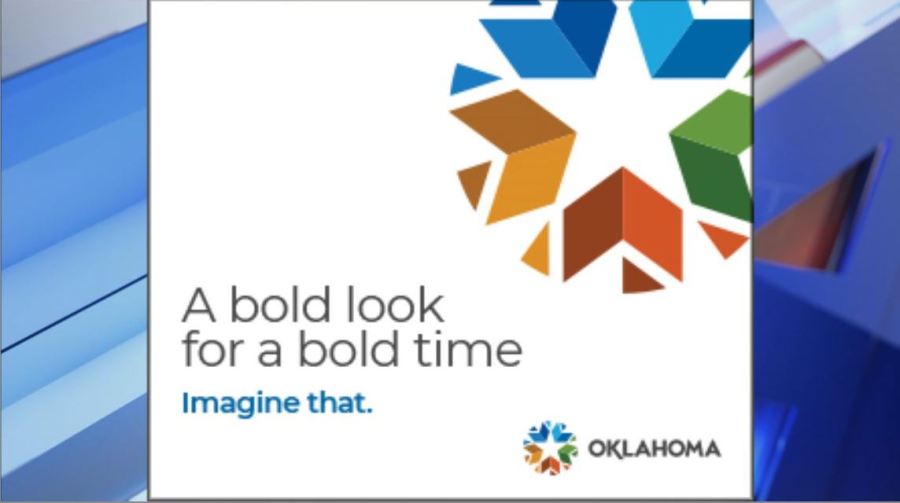 The Canadian firm We Are Operative was paid about $259,000.00 to manage the project. It did not provide creative services. Of that, $100,000.00 was donated by the MidAmerica Industrial Park in Pryor and the Chickasaw Nation, and the Oklahoma Business Roundtable provided about $30,000.00. Pinnell said officials wanted to get a consensus among Oklahoma marketing experts rather than choosing one. “We were very sensitive to the buy-in we wanted to have from Oklahomans,” Pinnell said. “To pitch to them we wanted their public service then select an Oklahoma company, I didn’t believe that would be very genuine. We wanted to be open and honest with why we went with who we went with.” The brand is being implemented across agencies with an eye toward redesigning web pages for better access and easier-to-understand navigation. The state hired a brand manager at a salary of $100,000.00. State funds for the project and new position are coming out of the existing budget of the Oklahoma Department of Commerce. “We’ve been through this before. Anyone who likes it isn’t going to send email or comment. People who like something will like it and go on. So we are only hearing from people who don’t,” Ewing said. “It’ll be like the Nike logo. We don’t have to explain its meaning or simplicity. That’s what this will become, too.  Instagram announced the platform is testing hiding “like” counts in the US after similar tests in countries including Australia, Japan, Canada, and Brazil. Facebook has also begun to trial this formula in Australia, and Twitter may come on board as they consider how to create “healthier conversations” on the platform. But what will this mean for brands and the $6.5 billion influencer industry that has given them an inside view into their customers? When Instagram tested likes in Canada, a study found that 41% of Canadian content creators said engagement dropped after Instagram like counts were hidden in the country. Creators who have had their likes hidden were also 2.5 times more likely to report not posting as often. This could cause major problems for brands relying on the platform and content creators as a primary form of engagement. Without likes, social media could become a stagnant form of customer engagement and with regulation over social media at a tipping point, brands may need to look elsewhere to interact with their customers and maintain loyalty. One platform that brands can utilize to create better customer engagement is messaging apps. Let’s explore the benefits of these platforms for customer engagement in a world without likes.  Nearly a third (31%) of consumers regard their interactions with brands as merely transactional, creating a major opportunity for brands to engage in meaningful interactions with consumers. On Instagram or Facebook, for example, when consumers follow a brand they experience a one-way engagement. The consumer sees the content the brand is pushing out, whether it’s a new product announcement or a tutorial, and the interaction often ends there. Messaging apps provide a unique opportunity for customers to engage directly with brands through two-way interactions. One-to-one contact between brands and customers is a building block for customer loyalty and the more personal experience available on messaging apps, such as direct and immediate customer service, can create a differentiator that keeps customers coming back in the future. Additionally, the adjustment to messaging apps is easy for consumers, as more than 2 billion people around the globe already use mobile messaging apps in their personal life to connect with friends or family. Instead of being inundated with influencer brand posts – 17% of companies are spending half of their Marketing budget on influencers and hyper-targeted advertising – the ability for consumers to opt-in or opt-out of communication with a brand creates more meaningful engagements between the brand and the consumer. Users can opt to follow a brand directly to engage in communication, receive customer service support through real-time chats or chatbots or receive alerts about special deals and new products. Because consumers are consciously choosing to receive this information from a brand, with the ability to stop the communication if it becomes overwhelming or unnecessary, it creates more positive interactions between users and brands. It also helps brand ROI, as highly-engaged customers will buy a product or service 90 percent more often and spend 60 percent more per transaction.  Many social media platforms have been caught in a stream of privacy scandals over the past two years, particularly related to the use of consumer data. In fact, nearly two-thirds of Americans believe it’s not possible to go through daily life without companies collecting data about them. Furthermore, 81% feel they have very little or no control over the data that companies collect from them and 79% are concerned about how companies use that data. Many messaging apps have taken a more forward-thinking approach to privacy by integrating end-to-end encryption into the platform to keep consumer data safe. With this model, users don’t need to worry about whether their data is being collected by brands or third-parties that will serve them unnecessary ads and potentially put their information at risk for a data breach. While only time will tell how social media will evolve without the impact of likes, when reevaluating priorities for 2020, brands should consider updating their strategies to focus on engagement strategies outside of social media to create more valuable engagements, instill consumer loyalty and provide user privacy.  Even with the popularity of social media, email still provides a unique set of benefits that other media channels struggle to match. There are many developments in email marketing that will help it remain the leader in digital marketing and eTargetMedia forecasts that email will propel to the top of every smart marketer’s campaign initiatives. Mobile browsing and mobile email have now surpassed desktop browsing in terms of traffic and email open rates. Across all digital marketing channels, marketers are realizing that websites and emails may need to be prioritized for mobile as we move into 2020 and not just optimized for mobile. Email marketers will need to make improvements to optimize for mobile emails including making copy easier to read on mobile devices, optimizing images for mobile and making the overall design and layout more friendly for mobile rendering. Artificial intelligence may sound overwhelming when it comes to email marketing but in most cases AI in email marketing relates to the automation of email messages. Email marketing automation focuses on providing relevant content to a specific individual at the most relevant time.  In 2020, emails are expected to become more interactive. Interactive elements like email carousels, embedded video, drop down menus and other interactive features will be added to email messages making them more interactive in the inbox. In the new year, eTargetMedia predicts that email subscribers will be interacting more with emails before they reach the landing page. Email marketing in 2020 should be all about creating a customer-centric experience. Brands are realizing that they can keep emails fresh and personalized by leveraging new email technologies, artificial intelligence, new design models and mobile optimized designs. The content of email in 2020 needs to be engaging, interactive, and personalized, all while respecting the user’s privacy and data. Partial source: Cristina Constandache, MarTech
 Beginning this month, businesses around the country are required to answer requests from Californians about personal data companies collect about them. A big change in data privacy protection is ramping up in California, and many businesses will soon feel its effects. Beginning this month, large businesses around the country that operate in California must disclose to their Golden State customers who ask for it any data the companies collect about them. Those customers can then request that the information be deleted or demand that it not be sold. Companies that fail to comply could face significant fees and penalties. The law, called the “California Consumer Privacy Act,” is the first sweeping data privacy measure in the country. It is intended to give consumers more control over their personal data at a time when breaches are rampant and personal information is mined, sold and used in ways consumers have little say over. The logistical challenges, independent of the legal challenges, are a significant undertaking for businesses who have to comply with the act. The law applies to for-profit companies that operate in California and meet one of three criteria: They have a gross annual revenue of at least $25 million; they buy, sell or share personal information for at least 50,000 California consumers; or they make at least half of their annual revenue by selling consumer data.  The companies that the law covers are mostly large private and public companies with significant reach. A report by California’s attorney general estimated that compliance will cost businesses roughly $55 billion initially, and the U.S. Department of Justice expects between 15,000 and 400,000 businesses to be affected nationwide. Fines for failing to comply range from $2,500 to $7,500 per violation. California’s law provides a broad umbrella for what constitutes personal information, going beyond the typical name and driver’s license number to include information such as internet browser history, geolocation data and audio. “All those kinds of information can be associated with a person and contain intensely private information,” said Jacob Snow, an attorney for the American Civil Liberties Union of Northern California who focuses on technology. One of the most significant aspects of the California law is a clause that gives the state’s consumers the right to sue over a data breach that meets certain criteria. If they are successful, companies who expose consumer data could be forced to pay between $100 and $750 per Californian affected by a breach and any other fees the court deems appropriate. California’s approach is starkly different from Florida’s. Like most states, Florida has few laws regulating data privacy. None allow consumers to fully understand where their data lives and to take it back as California’s does, though the Sunshine State does have a law requiring businesses to notify consumers after a data breach of a certain size. “Outside of that, there isn’t anything that really requires (companies) to take reasonable measures to protect personally identifiable information,” said Sri Sridharan, director of Cyber Florida, the cybersecurity center housed at the University of South Florida. A bill proposed recently by Sen. Doug Broxson, R-Gulf Breeze, would get Florida slightly closer to California’s law by requiring websites to tell Florida consumers what personal information it collects and let them opt out of the sale of their data. The regulation is widely considered to be the first in what will likely be a tide of similar state laws and potential federal legislation. That means companies will need to figure out how to comply with multiple laws and still do business effectively. You could end up with a federal floor and then still have different states that set different levels of privacy protections for consumers, even if those privacy levels conflict Some companies are expected to take a segmented approach for now, where they would have one division for California and one for the rest of the country, as many do to comply with Europe’s significantly more stringent data privacy laws. Others, such as Microsoft, are complying with California’s law and offering the same protections to customers around the country.  Not all Snapchat users are happy about the bold, new version of the ghost, but there is a very good why Snap made the change - and it might hint at the future of tech branding. Snapchat’s cute ghost logo is now surrounded by a decisively bold line that may feel too thick for comfort, at least at first glance. In fact, many users aren’t happy about the change and took to Twitter in numbers to express their feelings. An instant reaction and exposure to the discussion, and the App, reason number one? Snap says the bold line makes the app’s logo more visible and eye-catching. This is indeed true and because it’s so different from the thin lines that customary modern-day branding uses, it works. Still, some users are threatening to delete the app over it, or at least hide it away in a folder so they don’t have to look at it. One user described how it didn’t “match” the other apps on their phone. Thinness has become a design standard—largely thanks to Apple and its obsession with clean, thin minimalism. Across the internet, lighter line weights have become associated with the tech companies, as well as clean, clear, user-centered design—chunky lines look like Comic Sans compared to this sleek aesthetic. If you scroll through your phone and look at app icons, you’d be hard-pressed to find many apps that embrace the kind of thick line that Snap now has with its new logo.  But that’s also exactly what helps Snap—and the few other companies daring to move beyond the minimalist logo paradigm—stand out. The subtle shift makes sense within the context of the company’s latest release, Spectacles 3, which isn’t about pleasing the masses but is marketed instead to the creative, fashion-forward, early adopters of the world. Amid the clean lines and minimalism, Snap is bold and not afraid to show it. Source: Katharine Schwab, Fast Company.
 An organization on the cutting edge of nonprofits using technology is now innovating in its campaign for growth. TechSoup, which provides technology systems and assistance to charities around the world, is raising $11.5 million to increase the services it offers and the number of groups it serves. The organization is seeking both outright gifts and debt investments. A big part of the campaign is its direct public offering, which includes three tiers of debt investments. Individuals can invest small amounts, even if they’re not accredited investors, which is not the case with many impact investments. "It’s kind of like crowdfunding meets impact investment," says TechSoup’s CEO, Rebecca Masisak. The first tier of TechSoup’s offering lets supporters buy notes of $50 to $2,499. At the end of the term, investors will get their principal back along with 2 percent interest. The middle tier allows supporters to buy five-year notes of $2,500 to $49,999 at an interest rate of 3.5 percent. The third tier allows accredited investors and institutions to buy five-year notes of $50,000 or more at an interest rate of 5 percent. Paying Back Investors TechSoup believes the offering marks the first time the Securities and Exchange Commission has qualified a nonprofit to raise funds nationally through something called a Regulation A+/Tier 2 offering. Grants to fund specific programs are great, but it’s very difficult for an organization to expand its efforts using restricted money, Masisak says. Money the nonprofit earns from fees for products and services currently makes up 95 percent of TechSoup’s budget. The debt the organization raises will help it expand its services and earned income, which will allow it to pay back investors. "This capital, which will be unrestricted, will allow us to grow these new services, bring the impact, but also will financially make us stronger and allow for the returns." So far, more than $8 million has been committed to TechSoup’s growth campaign, almost all in the form of debt. The drive got a big boost today when VMware, a cloud-computing company in the Bay Area, announced a $2.5 million recoverable grant. (Recoverable grants are also known as forgivable loans. There is no possibility of default if the recipient cannot repay the money.) "It was really powerful to invest in TechSoup’s own organizational transformation, knowing that ripple effect that they have with the nonprofits that they serve," says Jessamine Chin, director of the VMware Foundation. "They have a strong reputation in this space for being forward thinking." Making a recoverable grant in TechSoup rather than an outright grant has been a learning opportunity for the VMware Foundation, Chin says. Grant makers think about potential grantees’ financial strength, she says, but that was magnified in this case as leaders discussed TechSoup’s ability to repay. "This is a new approach. I appreciate how inclusive they been to have not just having institutional investors but also including community members," she says. "It’ll also be interesting to see if other organizations choose to follow TechSoup’s path." Cloud Computing and A.I. TechSoup says its growth campaign is important because of transformation in digital technology. There was a time when TechSoup mailed free and discounted software to nonprofits, but the technology landscape has evolved significantly since then, says Masisak. Now organizations are dealing with cloud computing, artificial intelligence, blockchain, and more. "We feel like there’s so much need and so much opportunity to do more with technology for the sector," Masisak says. "We don’t want the sector to fall even further behind." Nicole Wallace has been reporting on nonprofits for the Chronicle for more than 20 years. Her areas of expertise include data, technology, fundraising, and innovation. In March, Nicole wrote about the use of artificial intelligence in fundraising. More info: Click here  Records show the Florida Department of Highway Safety and Motor Vehicles (FHSMV) made $77 million in 2017 by selling drivers' personal information to more than 30 private companies, including marketing firms, bill collectors, insurance companies and data brokers — and made Now, one Lakeland woman says she received an onslaught of robocalls, and direct mail offers as a result. Sonia Arvin lives with her twin sister, Tonia Baston, who just moved from Idaho. Arvin takes care of Baston, who has an intellectual disability, and is her legal guardian. "We took her to get an ID because she's a Medicaid patient," Arvin said. Days later, Arvin said Batson started receiving direct mail offers for lawn service, credit cards, cell phones and insurance. They now receive constant robocalls, and salespeople have even started showing up at their door. In Idaho, Batson lived in a group home where someone else handled her finances, daily living and healthcare arrangements. She had no digital footprint because she can't read or write. That's why Arvin wanted to know how marketers got her sister's personal information. "The only one that had it was the (FHSMV)," Arvin said. "Even if it's a public record in Florida – if we tell them we want it private, it should be kept private." While the FHSMV sells driver data to private companies, those companies are not permitted to use that data for marketing purposes. Once FHSMV officials were alerted to Baston's case, the state opened an investigation. It turns out that not every company plays by the rules. Florida says it has banned data sales to three companies since 2017 for misusing driver and ID cardholder information. Under the law, FHSMV must provide driver information but said federal privacy laws and its own rules limit how outside companies can access Florida residents' personal information. Read the state's privacy statement by clicking here. One of the data brokers accessing Florida DMV information is Arkansas-based marketing firm Acxiom, which has an agreement with the state to buy driver and ID cardholder data for one cent per record. On its website, Acxiom claims it has collected information from almost every adult in the United States. "Acxiom provides clients with access to 2.5 billion customers and two-thirds of the world's population," a promotional video on Acxiom's website says. The video also claims the company has a client list that includes banks, automakers and department stores. When asked how Axicom is using Florida drivers information, a company spokesperson declined an on-camera interview but provided a statement through email. "Acxiom acquires information from a variety of sources to inform its marketing and commercial products, including Acxiom's identity verification and fraud prevention products. We maintain all information in strict compliance with state and federal laws. But because sound data governance, including ethical and responsible use of information, is foundational to our business, we go beyond legal compliance to ensure additional transparency and clarity for consumers. To learn more about Acxiom's products, and the choices consumers have regarding the use of their information, please visit Acxiom.com." Miami attorney Al Saikali, who advises his clients how to legally and ethically use public data for commercial purposes, said his clients are increasingly using public records laws to obtain information for a cheap price. "We're only going to see this continue over time. Companies are going to continue to seek more data about you," Saikali said. "Companies are essentially paying for information, for leads, for lead generation." Saikali said consumers can limit the number of marketers contacting them by setting up a secondary email account to give government agencies — which are only checked periodically for renewal notices and other important information — and only giving a telephone number to government agencies when it's necessary. A state spokesperson said there's no way for drivers to opt-out if they don't want their personal information sold. "The Florida Department of Highway Safety and Motor Vehicles provides public records as legally required, in accordance with federal and state law, and as a necessary function in order for customers to efficiently conduct everyday business. The department has successfully instituted proactive security measures to ensure customer information is protected and any misuse of customer information will be pursued to the fullest extent of the law." |
BLOGArchives
January 2025
Categories
All
|
